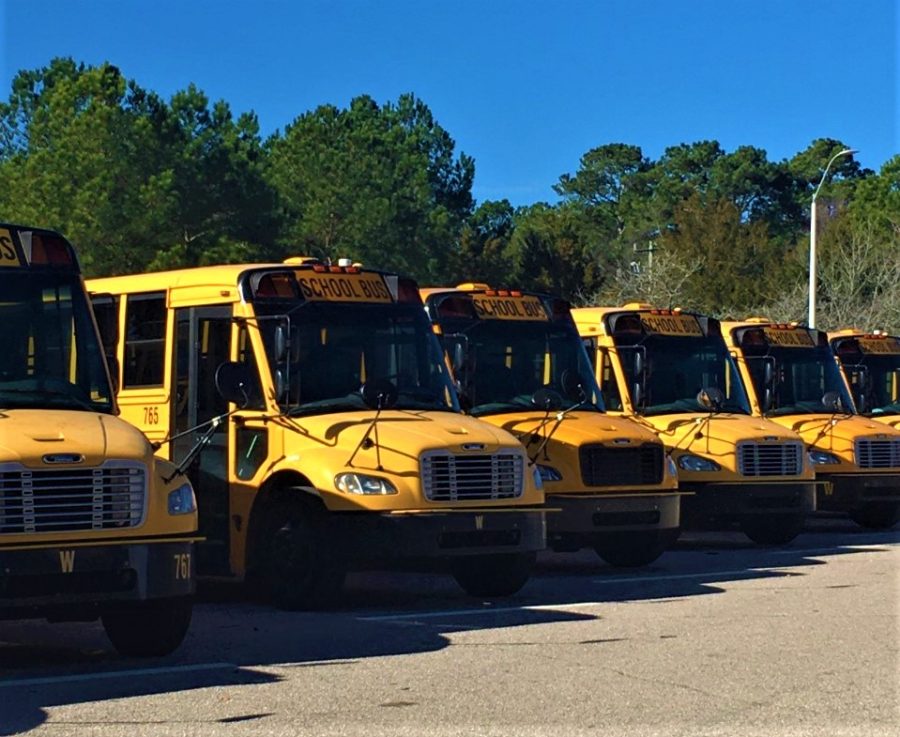Wakefield students impacted by bus driver shortage
On Friday, Oct. 29, multiple students in Wake County did not have access to transportation to and from school.
January 5, 2022
In North Carolina, 14,104 school buses run daily routes to and from school. On average there are over 700,000 people riding the bus every day, that’s about 55 percent of all students in the state. Most students who ride the bus either can’t walk to school or their parents cannot provide transportation for them.
On average, a school bus driver makes around $33, 971 a year. However, the range is pretty large as the lowest they make is around $27,426 and the highest they make is around $41,404. The average hourly pay is $17, with the range being $14 to $21 an hour.
The school bus driver strike started Friday, October 29, 2021. Wake County sent an email to families to let them know to prepare for “backup transportation” as the bus drivers are issuing a walkout. The walkout was issued as a protest against poor working conditions and low pay wages.
James “Jim” Milligan is a bus driver for Wakefield High School. He runs route six in the morning and route 28 in the afternoon.
“The main reason people went on strike was to bring attention to the way bus drivers are underpaid and the amount of work that is required of us, especially since Covid,” said Milligan. “What it really did was make people realize that we are taken for granted, without buses some people couldn’t get their kids to school.”
Not only does it stop people from getting to school, it also stops people from being able to get home from school.
Zoe Ruden is a freshman at Wakefield who realized after a while that her bus wasn’t going to come.
“It was hard getting home because both my parents work,” said Ruden. “My dad is gone most of the time and my mom works a lot.”
Students can’t stay after school unless they are accompanied by an adult for a club, sport, or office hours with a teacher. Not every student participates in these kinds of activities, so students who miss the bus have to find another way home.
“Sometimes I had to go over to my friend’s house,” said Ruden. “I would either walk to my friend’s house or stay after school for the play.”
Nara Hamburger is also a freshman who realized her bus was not going to be coming to campus.
“Luckily my parents work from home so it wasn’t as big of a deal, but some other people weren’t so lucky,” said Hamburger.
One thing that makes this situation harder for students and parents is that you never truly know when your bus is going to arrive. Whether you’re going home from school or coming to school, you can’t predict when or how it is getting there.
“When I had my original driver, the bus would arrive at my stop at around six o’clock because I’m the first stop,” said Ruden. “Now it’s 6:20 instead, so my mom and I will be sitting by the stop for 20 minutes waiting for it to come.”
Not only do the times change, but the drivers also change. When the driver changes to someone who has never driven that run before, it can put a lot of pressure on the driver and stress on the students.
“It was really annoying having different bus drivers everyday and not knowing which time they would come,” said Ruden.
Assistant Principal Heather Acrey has noticed an increase in students arriving earlier than usual, and being picked up later than expected.
“Students are arriving to campus as early as 6:30 by bus and not necessarily leaving until as late as 3:00 or 3:15 to accommodate double back routes,” said Acrey. “Overall, our students and families have been very understanding and made the best of an uncomfortable situation. I am deeply grateful for the generally supportive attitude of our community for our bus drivers.”
The Wake County public school system is working on supporting their bus drivers more appropriately. Not just for the students, but for the drivers themselves. In response to the strike, the Wake County Board of Education gave out a one-time bonus for all part-time and full-time bus drivers.
“I think if we were paid a decent wage it would go a long way towards making it better,” said Milligan. “The pay scale isn’t fair. I’ve been driving for over two and a half years, and if someone started tomorrow they’d make 27 cents less than me and they’d get a sign-on bonus.”
Being a bus driver isn’t just about being able to drive. The process of becoming a school bus driver takes time. You have to have at least six months of driving experience, have a School Bus Driver’s Certificate and hold a commercial driver license (CDL) with both “S” (school bus) and “P” (passenger) endorsements.
“People don’t realize what it takes to keep and maintain a CDL, we don’t get paid for that,” said Milligan. “Most drivers work a part-time job just to make ends meet. They really need to pay a wage that someone can live on. The minimum could start at $15, but the average good driver should make at least $20.”
The Wake County school system isn’t the only one that is helping the bus drivers feel more appreciated in their work. Students, staff, and parents also bring light to bus drivers’ lives.
“Please thank your bus drivers! As a school, we are so thankful for the commitment of the drivers we have,” said Acrey. “ During this season of thanks and generosity, I ask that you acknowledge your drivers. A kind word, heartfelt card and respectful attitudes can go a long way in recognizing their hard work.”









